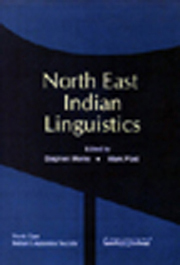Book contents
- Frontmatter
- Contents
- Introduction
- Foreword
- Phonology
- Lexicon
- Morphology, Syntax, and Semantics
- 9 Causative Prefixes in Four Boro-Garo Languages
- 10 Similarities in Verbal and Nominal Morphology In Atong
- 11 Temporality in Bishnupriya
- 12 Explicator Compound Verbs in Assamese and Kashmiri: A Comparative Analysis
- 13 Explorations in the Nonfinite Verbal System in Asamiya
- Language Description and Language Endangerment
10 - Similarities in Verbal and Nominal Morphology In Atong
from Morphology, Syntax, and Semantics
Published online by Cambridge University Press: 26 October 2011
- Frontmatter
- Contents
- Introduction
- Foreword
- Phonology
- Lexicon
- Morphology, Syntax, and Semantics
- 9 Causative Prefixes in Four Boro-Garo Languages
- 10 Similarities in Verbal and Nominal Morphology In Atong
- 11 Temporality in Bishnupriya
- 12 Explicator Compound Verbs in Assamese and Kashmiri: A Comparative Analysis
- 13 Explorations in the Nonfinite Verbal System in Asamiya
- Language Description and Language Endangerment
Summary
Introduction
Atong is a Tibeto-Burman language spoken in the beautiful mountainous region along the Simsang River, between the villages of Nongal Bibra and Baghmara in the Garo Hills in the state of Meghalaya, India. There are an estimated 15 to 20 thousand speakers of Atong. This estimate is given by the Atong people themselves. Officially the Atong are grouped together with the Garos. Garo is the name given by outsiders to the Tibeto-Burman people living in the Garo Hills and adjacent areas who speak a group of dialects also called Garo. The Atong language, which has no official status, is mistakenly considered to be a dialect of Garo by the majority of people living in the Garo Hills. The image that Atong people seem to have of themselves is that they are a distinct group among the Garos. Some Atong do not identify themselves with the Garos at all.
The Atong speaking area can be roughly divided into two dialectal areas, viz. a Nongal-Rongsu area (north) and a Siju-Baghmara area (south). Due to the mobility of people in the area and of men in particular, Atong speakers are aware of the dialectal differences which are mostly lexical and prosodic in nature and show very little grammatical differentiation. The dialects are perfectly mutually intelligible. There is some dialect mixing in the area. The Atong are a matrilineal and matrilocal society. When a boy marries he will move into the house of the family of his wife, even if she lives in another village. Further dialect mixing occurs at the market where people from different villages come together.
- Type
- Chapter
- Information
- North East Indian Linguistics , pp. 168 - 190Publisher: Foundation BooksPrint publication year: 2008

